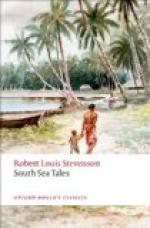The reader may think I have forgot the sea. The two beaches do certainly abound in life, and they are strangely different. In the lagoon the water shallows slowly on a bottom of the fine slimy sand, dotted with clumps of growing coral. Then comes a strip of tidal beach on which the ripples lap. In the coral clumps the great holy-water clam (Tridacna) grows plentifully; a little deeper lie the beds of the pearl-oyster and sail the resplendent fish that charmed us at our entrance; and these are all more or less vigorously coloured. But the other shells are white like lime, or faintly tinted with a little pink, the palest possible display; many of them dead besides, and badly rolled. On the ocean side, on the mounds of the steep beach, over all the width of the reef right out to where the surf is bursting, in every cranny, under every scattered fragment of the coral, an incredible plenty of marine life displays the most wonderful variety and brilliancy of hues. The reef itself has no passage of colour but is imitated by some shell. Purple and red and white, and green and yellow, pied and striped and clouded, the living shells wear in every combination the livery of the dead reef—if the reef be dead—so that the eye is continually baffled and the collector continually deceived. I have taken shells for stones and stones for shells, the one as often as the other. A prevailing character of the coral is to be dotted with small spots of red, and it is wonderful how many varieties of shell have adopted the same fashion and donned the disguise of the red spot. A shell I had found in plenty in the Marquesas I found here also unchanged in all things else, but there were the red spots. A lively little crab wore the same markings. The case of the hermit or soldier crab was more conclusive, being the result of conscious choice. This nasty little wrecker, scavenger, and squatter has learned the value of a spotted house; so it be of the right colour he will choose the smallest shard, tuck himself in a mere corner of a broken whorl, and go about the world half naked; but I never found him in this imperfect armour unless it was marked with the red spot.




